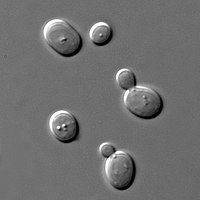
Photo from wikipedia
Abstract A mathematical model was developed to increase the understanding of stress concentrations within a gas cell wall (GCW) in bread dough during baking. The GCW was composed of a… Click to show full abstract
Abstract A mathematical model was developed to increase the understanding of stress concentrations within a gas cell wall (GCW) in bread dough during baking. The GCW was composed of a single A-type wheat starch granule surrounded by various proportions of gluten typical of GCWs when about to rupture. Finite element simulations were carried out in 2D using linear viscoelasticity and visco-hyperelasticity. Strain orders of magnitude and rates relevant to dough during baking were applied as boundary conditions for two plausible sets of mechanical properties before and after protein coagulation and starch gelatinization (T 70–80 °C). The average stress within the GCW was found to be strongly dependent on the starch fraction. Gluten-starch interactions influenced average stress values considerably when the starch fraction was greater than 11% v/v. The locations within the GCW where rupture was most likely to be initiated were identified by mapping maximal stress points using stress field and triaxiality analysis and the findings were discussed.
Journal Title: Journal of Food Engineering
Year Published: 2021
Link to full text (if available)
Share on Social Media: Sign Up to like & get
recommendations!